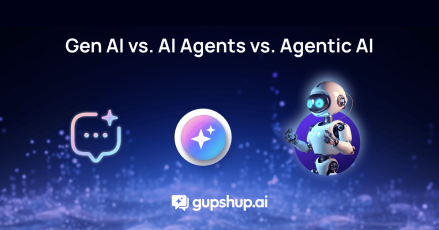How to Humanize AI in Business Conversations

Remember walking into a store and being greeted by name or having a friendly chat as you checked out? Those personal touches built lasting relationships.
Today’s businesses have access to myriad tech solutions promising smarter workflows and heightened efficiency – from grocery shopping to big-ticket purchases like cars or jewelry, everything is becoming increasingly virtual.
Yet, with all these advancements, customer expectations have paradoxically remained rooted in tradition. Shoppers navigating through virtual aisles still seek the warmth and familiarity of human interactions, even from AI-driven systems.
Recent studies highlight a significant trend: while 80% of business leaders believe that AI and automation are essential for their business operations, nearly 76% of customers report frustration when their experiences feel too impersonal.
This reveals a crucial gap: the need to humanize AI to streamline operations, enhance customer interactions, and build deeper relationships.
Given this, you may be exploring ways to integrate AI more seamlessly into your business conversations without losing that personal touch.
This blog offers practical steps and strategies to humanize your AI interactions, by enhancing customer satisfaction and business performance. Let’s dive into how you can maintain the delicate balance of automation and personalization.
Ways to Enhance Human Element in AI Conversations
To make AI-driven conversations feel more genuine and engaging, businesses are increasingly focused on enhancing the human element within their AI chatbots. As we delve into practical ways to humanize AI interactions, it’s important to recognize the impact such enhancements can have. For instance –

These statistics demonstrate a clear shift towards more positive perceptions of AI in customer service roles.
Now, let’s get into different ways to humanize your chatbots –
Proactive Chatbots and Personalized Experiences
Business-customer engagement dynamics are changing NOW.
Initially, chatbots reacted only after a customer-initiated contact. But now, modern chatbots powered by advanced AI are no longer just responsive—they’re now taking the initiative. They initiate conversations based on user behavior and data analytics, creating a more personalized consumer journey.
These advanced AI-driven systems go beyond simple automated responses. They are designed to anticipate a customer’s needs and preferences based on past interactions. This enables them to initiate relevant conversations at the right moment, making them more “human.”
This humanization of chatbots is a major and important shift, especially in how businesses use chatbots with technologies like Click to WhatsApp ads. Such ads make this proactive approach more impactful by initiating direct conversations via ads on social media platforms, where the AI can immediately engage.
For instance, if a customer frequently checks out certain products but leaves without purchasing, a proactive chatbot can send a personalized reminder or offer a special discount on those items, directly through WhatsApp. This not only keeps the product top of mind but also makes the interaction feel tailored to the individual’s specific interests.

These chatbots can also send follow-up communications effectively. After purchase, a chatbot might send care tips and related products or ask for feedback, all based on the customer’s purchase history and previous interactions. This continuous engagement strategy helps in nurturing a deeper connection with customers, making them feel valued and understood.
Building Empathy and Authenticity in AI Conversations
Nowadays, chatbots aren’t just scripted responders; they’re designed to perceive and react to human emotions effectively. This shift toward what experts call “artificial empathy” means that AI can now better recognize emotional cues and respond in ways that are both appropriate and contextually relevant.
Let’s look at an example. Consider a customer who expresses frustration over a delayed order.
“I totally understand why you’re upset, and I’m here to sort this out quickly for you. Let’s track your order and see how we can expedite it.”
This empathetic chatbot, equipped with advanced natural language processing tools, can understand the tone and content of the customer’s message and respond. It gives an update, an apology, and perhaps an offer to make things right. This kind of interaction goes beyond mere transactional responses; it builds a relationship and trust between the customer and the brand.
These AI systems can also remember past interactions. It allows them to personalize conversations. If a customer had a previous issue that was resolved, the chatbot can refer back to that resolution in future discussions, showing the customer that they are not just another number in the database. This enhances customer satisfaction and loyalty.
So, how does this all come into play? By using AI as a part of the customer service team that understands, remembers, and cares.
Train AI with Brand-Specific Data
Training AI models on a dataset that includes brand-specific communications, such as customer emails, support tickets, and chat logs, enable the AI to learn and mimic the brand’s unique style and tone.
Let’s look at an example of a Swiss Luxury fashion brand. This brand leveraged Gupshup’s conversational AI to enhance its customer engagement and sales conversion rates. The digital shopping assistant provided by Gupshup enabled the brand to integrate personalized services across the webshop, Facebook, WhatsApp, and in-store channels, which significantly improved the conversion rate by 8.5%.
Let’s look at a template –
In this example, the conversational AI is designed to enhance customer experience by humanizing interactions, much like a skilled sales assistant in a luxury brand setting. It demonstrates this by providing guided question options to help customers articulate their needs, using natural language for queries and responses. It also ensures a feedback loop by asking for confirmation if the customer’s question was sufficiently addressed.
This approach creates a more engaging and satisfying interaction for customers, reminiscent of the attentive and personalized service offered by high-end retailers.
Incorporating Human Touch Through Content and Feedback
Adding a human touch involves more than just personalizing interactions; it requires AI to engage in ways that feel genuinely human, even when you are just asking for customer feedback. This can be achieved by programming AI to offer responses and support and actively seeking feedback to improve its interactions continuously.
Even the best AI tools require a human touch to ensure the content is engaging and error-free. Editing AI outputs is essential to maintain quality and authenticity.
For instance, after resolving a customer’s issue, AI can ask for feedback in a conversational manner, using the insights gathered to refine future interactions and make them more human-like.
“Thanks for letting me assist you with your issue today! I hope everything was resolved to your satisfaction.
Could you spare a moment to rate your experience? It helps us improve and ensure we’re on the right track. Just type ‘great,’ ‘good,’ or ‘needs improvement’.
Thanks for taking the time and helping us serve you in a better way!”
Establishing a feedback loop with users can help continuously improve the AI’s performance. Feedback mechanisms can identify areas where the AI may not meet user expectations and provide data to refine its responses. This is a great way to give your customers a feeling of being involved with your brand.
Build a Culture of AI Ethics
Transparency and trust in AI have become a must-have.
With AI deeply involved in daily operations from healthcare to finance, understanding how AI systems make decisions is important for both trust and compliance. According to AIBM, AIS trustworthiness centers on five key principles –
transparency, expendability, fairness, robustness, and privacy.
You can consider these as pillars that support the kind of ai you can trust. Transparency isn’t about opening up the black box of ai algorithms. It’s about making them understandable and accessible to everyone impacted by their decisions.
Consider security and data privacy – areas where AI transparency is non negotiable. AI systems are gold mines of data. This is what makes them the prime targets of cyber threats. Robust security measures like encryption and careful data handling practices help mitigate these risks, ensuring that personal data isn’t just secure but also treated ethically.
So, is all this focus on transparency and trustworthiness worth the effort and investment? Absolutely. However, integrating ethical practices into AI development may come at a cost, but the payoff in user trust and regulatory compliance is invaluable.
It’s all about setting up a system where AI enhances operational efficiency and aligns with broader societal values.
And here is the best part: while you might start with basic AI capabilities, understanding and implementing these foundational principles from the get-go will make scaling up that much smoother. You will now invest in a technology that will continually enhance its credibility and reliability.
Data-Driven Dialogues — Crafting Smarter Conversations with Conversational AI

Gupshup’s Conversation Cloud is a transformative platform designed to humanize AI in business conversations by providing a full suite of AI-powered tools. This platform helps businesses create conversational experiences that are seamless, personalized, and efficient across the entire customer journey. From acquisition through marketing to post-purchase interactions – Conversational Cloud can be your one-stop solution.
The Conversation Cloud allows for integrations across multiple conversational channels like WhatsApp, SMS, and social media platforms, ensuring that businesses can meet customers on their preferred platforms. This omnichannel capability is crucial for maintaining consistency and accessibility in customer interactions.
One of the standout features of Gupshup’s platform is its advanced AI integration, which uses technologies like natural language processing and machine learning to automate content generation and manage responses intelligently. This enhances engagement by allowing for real-time, relevant interactions and significantly boosts operational efficiency by automating routine tasks.
Moreover, Gupshup’s Conversation Cloud provides actionable analytics, giving businesses critical insights into campaign performance and customer engagement metrics. These insights are vital for continuously refining strategies and improving customer satisfaction.
Gupshup’s Conversation Cloud offers a comprehensive solution for businesses looking to use conversational AI to enhance customer experiences, improve engagement, and drive growth efficiently.
What Next?
Incorporating AI in business is considered to be a trend, but it is actually an essential strategy that enhances customer engagement by humanizing digital dialogues. Leveraging real-time, data-driven insights personalizes interactions, making them relevant and empathetic.
Selecting the right AI tools is also important for aligning with brand identity to ensure that automated interactions resonate authentically. Platforms like Gupshup further refine this integration, linking with systems like WhatsApp to enhance communicative efficacy.
Businesses embracing this blend of AI sophistication and human-centric approaches are set to redefine customer relationships, making digital engagements efficient and also genuinely connective.






